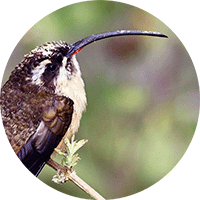Tawny-bellied Hermit
The Tawny-bellied Hermit (Phaethornis syrmatophorus) Read in Spanish
Appearance: The Tawny-bellied Hermit is a medium-sized hummingbird with a distinctive appearance. It has iridescent green upperparts, a tawny-colored belly, and a white vent area. The bill of the Tawny-bellied Hermit is long and slightly curved, adapted for feeding on nectar from flowers.
Habitat:
The Tawny-bellied Hermit inhabits humid forests, forest edges, and secondary growth areas. It can be found in both lowland and montane forests in regions with a variety of flowering plants for nectar.
Behavior: This hummingbird species is known for its agile flight and its ability to hover in front of flowers while feeding on nectar. Tawny-bellied Hermits can be solitary or found in pairs, often defending territories against intruders. They may also engage in aggressive behaviors towards other hummingbirds to secure food sources.
Breeding: During the breeding season, male Tawny-bellied Hermits may perform aerial displays and vocalizations to attract females. The female constructs a cup-shaped nest using plant fibers, spiders' silk, and other materials placed in a sheltered location within the forest. The female is solely responsible for incubating the eggs and caring for the young once they hatch.
Conservation Status: The Tawny-bellied Hermit is classified as Least Concern on the IUCN Red List.
Distribution
The Tawny-bellied Hermit (Phaethornis syrmatophorus)
Andean Region: The Tawny-bellied Hermit is commonly found in the Andean region of Colombia, including the Central and Eastern Andes. Within the Andean region, the species is known to occur in montane forests at different elevations, taking advantage of the diverse vegetation and flowering plant species present.
Northern Colombia: Parts of northern Colombia, including the Sierra Nevada de Santa Marta and the Serranía de Perijá, are areas where the Tawny-bellied Hermit can be observed. These regions contain various habitats such as cloud forests and humid forests that are suitable for hummingbirds like the Tawny-bellied Hermit.
Eastern Cordillera: It is also found in the Eastern Cordillera of Colombia, which is known for its diverse ecosystems and high levels of biodiversity. This region provides important habitat for the species, supporting its foraging and breeding activities.
Taxonomy
The Tawny-bellied Hermit (Phaethornis syrmatophorus)
- Kingdom: Animalia
- Phylum: Chordata
- Class: Aves (Birds)
- Order: Caprimulgiformes
- Family: Trochilidae
- Genus: Phaethornis
- Species: Phaethornis syrmatophorus
Vocalization
The vocalization of the Tawny-bellied Hermit (Phaethornis syrmatophorus) typically consists of a variety of sounds produced by both sexes for communication and territorial purposes.
- Chirping and Chattering: Tawny-bellied Hermits are known to produce high-pitched chirps and chatters as part of their vocal repertoire. These sounds are often used for intra- and inter-specific communication, including signaling presence, establishing territories, and attracting mates.
- Whistles and Trills: The Tawny-bellied Hermit may produce whistling notes and trills, which can be heard during territorial disputes or courtship displays. These vocalizations can vary in pitch and duration, serving as distinctive calls within the species' communication network.
- Buzzing and Wing Whirring: In addition to vocal sounds, Tawny-bellied Hermits are also known for producing mechanical sounds such as buzzing and wing whirring during flight displays and interactions. These sounds, created by the rapid movement of their wings, complement their vocalizations and add to the overall communication repertoire of the species.
- Singing and Squeaking: Tawny-bellied Hermits may exhibit more melodic singing patterns and occasional squeaking sounds, particularly during interactions with other individuals or when defending their territories. These vocalizations can be complex and may include rapid sequences of notes or calls that are distinctive to the species.





